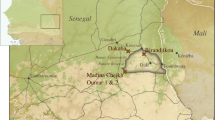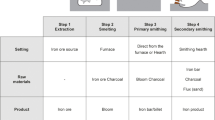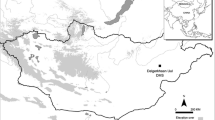Abstract
Mbinga is one of many areas in Tanzania with deep-rooted evidence of archaeology. Archaeometallurgically, the area has remained terra incognita. This paper focuses on Mbinga’s technological change and continuity of iron production techniques in the first and second millennium AD. To achieve this, archaeological data were collected through ethno-history, archaeological survey, excavation, and physical attribute methods, while archaeometric data were generated through optical microscopy, electron microscopy, and metallographic techniques. The results indicate that over the last 1500 years, there has been technological change in iron smelting techniques in terms of furnace charging platform, slag-pit provision, slag tapping, use of multiple tuyères per tuyère port, reduction efficiency, utilized iron ore, and final smelting product. While change took place, there has been technological continuity in the furnace construction materials, forced air supply, and spatial organization of iron smelting activities. The change and continuity in the technology of iron production in Mbinga were probably driven by demand for iron tools for socio-economic purposes, environment, technological efficiency, and the demand for production of carbon-rich steel tools.











Similar content being viewed by others
References
Anderson MS (2009) Marothodi: the histori cal archaeology of an African capital. Northamptonshire, Atikkam Media Limited
Anthony JW, Bideaux RA, Baldh KW, Nichols MC (1997) Handbook of mineralogy, volume III: halides, hydroxides, oxides. Mineral Data Publishing, Tucson
Avery DH, Schmidt PR (1979) A metallurgical study of the iron bloomery, particularly as practised in Buhaya. JOM 31:18
Avery DH, Schmidt PR (1983) More evidence for an advanced prehistoric iron technology in Africa. J Field Archaeol 18(4):421–434
Bachmann H (1982) The identification of slags from archaeological sites, occasional publication no.6. Institute of Archaeology, London
Bandama F, Chirikure S, Hall S (2013) Ores sources, smelters and archaeometallurgy: exploring iron age metal production in the Southern Waterberg. J Afr Archaeol 11(2):243–267
Barndon R (1996) Fipa ironworking and its technological style. In: Schmidt PR (ed) The culture and technology of African iron production. University Press Florida, Florida, pp 58–73
Barndon R (2004) An Ethnoarchaeological study of iron smelting practices among the Pangwa and Fipa in Tanzania. Archaeopress, Oxford
Bennett A (2013) Protohistoric iron weapons and tools from a burial site in West Central Thailand. In: Humphris J, Rehren T (eds) The world of iron. Archetype Publications, London, pp 377–379
Berry L (1971) Relief and physical features 1. In: Berry L (ed) Tanzania in maps. University of London Press Ltd, London, pp 24–25
Biginagwa TJ, Mapunda BB (2017) The Kilwa-Nyasa caravan route: the long-neglected trading corridor in southern Tanzania. In: Wynne-Jones S, LaViolette A (eds) The Swahili world. Routledge, New York, pp 541–553
Brock B, Brock PWG (1965) Ironworking amongst the Nyiha of southwestern Tanganyika. S Afr Archaeol Bull 20(78):97–100
Chami F (1994) The Tanzania coast in the first Millenium AD: archaeology of the ironworking, farming communities, vol 7. Societas Archaeological Upsaliensis, Uppsala
Chami F (2005) Current archaeological research in mainland Tanzania. In: Mapunda BB, Msemwa P (eds) Salvaging Tanzania’s Cultural Heritage Dar es Salaam. Dar es Salaam University Press, London, pp 81–89
Chaplin JH (1961) Notes on traditional smelting in northern Rhodesia. S Afr Archaeol Bull 16:53–60
Childs ST (1996) Technological history and culture in western Tanzania. In: Schmidt PR (ed) The culture and Technology of African Iron Production. University Press Florida, Florida, pp 277–317
Chirikure S (2005) Iron production in iron age Zimbabwe: stagnation or innovation? Institute of Archaeology, University College London, London
Chirikure S (2006) New light on Njanja ironworking: towards systematic encounter between ethnohistory and archaeometallurgy. S Afr Archaeol Bull 61(184):142–151
Chirikure S, Bandama F (2014) Indigenous African furnace types and slag composition—is there a correlation? Archaeometry 56(2):296–312
Chirikure S, Rehren T (2006) Iron smelting in pre-colonial Zimbabwe: evidence for diachronic change from Swart village and Baranda, northern Zimbabwe. J Afr Archaeol 4(1):37–54
Collett DP (1993) Metaphors and representations associated with precolonial iron-smelting in eastern and southern Africa. In: Shaw T, Sinclair P, Andah B, Okpoko A (eds) The archaeology of Africa: food, metals, and town. Routledge, London, pp 499–511
Craddock P, Freestone I, Middleton A, Van Grunderbeek M (2007) Early Iron age iron-smelting debris from Rwanda and Burundi, East Africa. Hist Metall 41(1):1–14
David N, Heimann R, Killick DJ, Wayman M (1989) Between bloomery and blast furnace: Mafa-iron smelting technology in North Cameroon. Afr Archaeol Rev 7:183–208
Davison S, Mosley PN (1988) Iron smelting in the upper north Rukuru Basin of northern Malawi. Azania 23:57–100
de Barros P (2000) Iron metallurgy: sociocultural context. In: Vogel J (ed) Ancient African metallurgy. AltaMira Press, Walnut Creek, pp 147–198
Greig RCH (1937) Iron smelting in Fipa. Tanganyika Note and Records 4:77–80
Haaland H (1994) Dakawa: an Early Iron Age site in the Tanzanian hinterland. Azania 29-30:238–247
Haaland R (2004a) Iron smelting- a vanishing tradition: ethnographic study of this craft in south-west Ethiopia. J Afr Archaeol 2(1):65–79
Haaland R (2004b) Technology, transformation and symbolism: ethnographic perspective on European ironworking. Nor Archaeol Rev 37:1–19
Haaland R (2005) New perspectives on the technology and socio-cultural context of iron working at Dakawa. In: Mapunda BB, Msemwa P (eds) Salvaging Tanzania Cultural Heritage. Dar es Salaam University Press, Dar es Salaam, pp 190–197
Haaland H, Msuya CS (2000) Pottery production, iron working and trade in the Early Iron Age: the case of Dakawa east-central Tanzania. Azania 35:75–106
Hall S, Miller D, Anderson M, Boeyens J (2006) An exploratory study of copper and iron production at Marothodi, an early 19th century Tswana town, Rustenburg District, South Africa. J Afr Archaeol 4(1):3–35
Hatton JS (1967) Notes on Makalanga iron smelting. NADA 9(4):39–42
Herbert EW (1993) Iron, gender and power: rituals of transformation in African societies. Indiana, Bloomington
Ige A, Rehren T (2003) Black sand and iron stone: iron smelting in Modakeke, Ife, south Nigeria. Inst Archaeometal Stud 23:15–20
Iles L, Lyaya EC (2015) Making metals in East Africa and beyond: archaeometallurgy in Azania, 1966–2015. Azania: Archaeol Res Afr 50(4):481–494. https://doi.org/10.1080/0067270X.2015.1102941
Iles L, Martinon-Torres M (2009) Pastoralist iron production on the Laikipia plateau, Kenya: wider implications for archaeometallurgical studies. J Archaeol Sci 36:2314–2326
Iles L, Stump D, Heckmann M, Lang C, Lane PJ (2018) Iron production in north pare, Tanzania: archaeometallurgical and geoarchaeological perspectives on landscape change. Afr Archaeol Rev 35:507–530. https://doi.org/10.1007/s10437-018-9312-4
Jackson IJ (1971) Rainfall. In: Berry L (ed) Tanzania in maps. University of London Press Ltd, London, pp 36–38
Kapinga V (1990) Kuathiriwa kwa Maendeleo ya Mwafrika: Mfano Halisi Tanzania [How an African development were affected: real example from Tanzania]. Peramiho Printing Press, Peramiho
Keay RWJ (1959) Vegetation map of Africa. Oxford University Press, Oxford
Killick D (1991) A little-known extractive process: iron smelting in natural-draft furnaces. J Miner Met Mater Soc 43(4):62–64
Killick D (2004) What do we know about African ironworking? J Afr Archaeol 2(1):97–112
Killick, D.J. & Gordon, R.B. (1989). The mechanism of iron production in the bloomery furnace. In R. M. Farquhar, R. G. V. Hancook & L. A. Pavlish (Eds., Proceedings of the 26th International Archaeometry Symposium, held at University of Toronto, Toronto, Canada, May 16th to 20th 1988. University of Toronto: Toronto. pp. 120–123
Lind EM, Morrison MES (1974) East African vegetation. Longman Group Ltd, London
Liu Y, Martinón-Torres M, Chen J, Sun W, Chen K (2019) Iron decarburization techniques in the eastern Guanzhong Plain, China, during late warring states period: an investigation based on slag inclusion analyses. Archaeol Anthropol Sci 11:6537–6549. https://doi.org/10.1007/s12520-019-00921-5
Lyaya EC (2010) From Fipa to Nyiha case study: the bloom refining process in Mbozi, Tanzania. Nyame Akuma 74:25–35
Lyaya EC (2011) Bioarchaeometallurgy, technology, and spatial organization of ironworking at Mjimwema, Njombe Tanzania. Papers Inst Archaeol 21:66–86
Lyaya EC (2013) Use of charcoal species for ironworking in Tanzania. In: Humphris J, Rehren T (eds) The world of iron. Archetype Publications, London, pp 444–453
Lyaya EC (2016) Archaeological evidence for modes of air supply into iron smelting furnaces in the African Great Lakes region. Azania: Archaeol Res Afr 51(3):1–18. https://doi.org/10.1080/0067270X.2016.1210365
Lyaya EC (2019) An identification guide for metallurgical sites in Tanzania. Afr Archaeol Rev 36(2):1–17. https://doi.org/10.1007/s10437-019-09334-0
Lyaya EC, Mapunda BB (2014) Metallurgy in Tanzania. In: Selin H (ed) Encyclopaedia of the history of science, technology and medicine in non-Western cultures. Springer Netherlands, Netherlands, pp 1–9
Mansour S (1989) Use of ZAF and PAP matrix correction models for the determination of carbon in steels by electron probe microanalysis. X-Ray Spectrom 18(6):263–266
Mapunda BB (1991) Ironworking along the Lower Ruhuhu River Basin, Southern Tanzania: report and tentative conclusions. University of Florida, Florida
Mapunda, B.B. (1995a). An archaeological view of the history and variation of ironworking in Southwestern Tanzania. University of Florida: \
Mapunda BB (1995b) Iron age archaeology in the south-eastern Lake Tanganyika region, southwestern Tanzania. Nyame Akuma 43:46–57
Mapunda BB (2001) The archaeology of the Ruhuhu river basin, eastern shore of Lake Nyasa. In: Chami F, Pwiti G, Radimilahy C (eds) People, Contacts, and the Environment in the African Past. DUP (1996) Ltd, Dar es Salaam, pp 98–112
Mapunda BB (2002a) Iron metallurgy along the Tanzanian coast. In: Chami F, Pwiti G (eds) Southern Africa and the Swahili World, Studies in the African Past 2. Dar es Salaam University Press, Dar es Salaam, pp 76–88
Mapunda BB (2002b) Ufundichuma Asilia Africa Mashariki: Chimbuko Kukua na Kukoma Kwake [indigenous ironworking in East Africa: origins, development, and termination]. Peramiho Printing Press, Peramiho
Mapunda BB (2003a) Fipa iron technologies and their implied social history. In: Kusimba CM, Kusimba SB (eds) East African archaeology foragers, potters, smiths and traders. University of Pennsylvania Museum of Archaeology and Anthropology, Philadelphia, pp 71–85
Mapunda BB (2003b) Iron technology and deforestation: myths and realities. University of Sussex: AFRAS
Mapunda BB (2004a) East African slave trade: unravelling post-abolition slave coverts in the interior of southern Tanzania. UTAFITI 5(1):61–76
Mapunda BB (2004b) Iron technology and its social implications: the case of the Fipa Southwestern Tanzania. In: Oestigaard T, Anfinset N, Saetersdal T (eds) Combining the past and the present: archaeological perspectives on society. British Archaeological Press, London, pp 75–85
Mapunda BB (2010a) Contemplating the Fipa ironworking. Fountain Publishers, Kampala
Mapunda BB (2010b) Reexamining the Maji Maji War in Ungoni with a blend of archaeology and oral history. In: Giblin J, Manson J (eds) Maji Maji: lifting the fog of war. Brill, Leiden and Boston, pp 221–238
Mapunda BB, Burg S (1991) Preliminary report on archaeological reconnaissance along the Ruhuhu river basin, southern Tanzania. Nyame Akuma 36:32–40
Masao FT (2005) Archaeological research in mainland Tanzania up to the 1990s. In: Mapunda BB, Msemwa P (eds) Salvaging Tanzania’s Cultural Heritage. Dar es Salaam University Press, Dar es Salaam, pp 59–80
Miller D, Killick DJ (2004) Slag identification at southern African archaeological sites. J Afr Archaeol 2(1):23–47
Moore JE (1971a) Vegetation associations. In: Berry L (ed) Tanzania in Maps. University of London Press Ltd, London, pp 30–31
Moore JE (1971b) Soils. In: Berry L (ed) Tanzania in Maps. University of London Press Ltd, London, pp 28–29
Morton GR, Wingrove J (1969) Construction of bloomery slags: part I: Roman. J Iron Steel Inst 207:1556–1564
Morton GR, Wingrove J (1972) Construction of bloomery slags: part II: medieval. J Iron Steel Inst 210:478–488
Mtetwa E (2017) Technology, ideology and environment: the social dynamics of iron metallurgy in Great Zimbabwe AD 900 to Present. Uppsala University, Uppsala
Pleiner R (2000) Iron in archaeology. The European Bloomery smelters. Praha, Archeologický Ústav Avcr
Pole LM (2010) The hammers of Mawu: ironworking traditions in the Togo hills, Ghana-recent Iron Age (seventeenth to twentieth centuries), Ghana, west Africa. Afr Archaeol Rev 27:43–78
Quansheng H, Yanxiang L (2013) Preliminary studies on Western Han Dynasty iron smelting sites and slag found in Pingnan county, Guangxi province, China. In: Humphris J, Rehren T (eds) The world of iron. Archetype Publications, London, pp 333–341
Raum O (1973) The social function of avoidances and taboo among the Zulu. Walter de Gruyter, Berlin
Raymaekers J, Van Noten F (1986) Early iron furnaces with ‘bricks’ in Rwanda: complimentary evidence from Mutwarubona. Azania 21:65–84
Rehren T, Charlton M, Chirikure S, Humphris J, Ige A, Veldhuijzen HA (2007) Decisions set in slags: the human factor in African smelting. In: Niece SL, Hook D, Craddock P (eds) Metals and Mines: Studies in Archaeometallurgy. Archetype in association with the British Museum, London, pp 211–218
Reid A (1994) Early settlement and social organization in the interlacustrine region. Azania 29-30:303–313
Reid A, McLean R (1995) Symbolism and the social contexts of iron production Karagwe. World Archaeol 27(1):144–161
Renfrew C, Bahn P (2012) Archaeology: theories, methods, and practice, 6th edn. Thames & Hudson, London
Schlüter T (2006) Geological atlas of Africa. Springer, Berlin
Schmidt PR (1988) Eastern expression of the Mwitu tradition: Early Iron Age industry of the Usambara Mountain, Tanzania. Nyame Akuma 30:36–37
Schmidt PR (1996) Reconfiguring the Barongo: reproductive symbolism and reproduction among a work association of iron smelters. In: Schmidt PR (ed) The culture and technology of African iron production. University Press Florida, Gainesvill, pp 74–127
Schmidt PR (1997) Iron technology in East Africa: symbolism, science, and archaeology. James Curry, Oxford
Schmidt PR (2006) Historical archaeology in Africa: representations, social memory, and Oral traditions. Altamira Press, Lanham
Schmidt PR, Avery DH (1978) Complex iron smelting and prehistoric culture in Tanzania. Science 201(4361):1085–1089
Schmidt PR, Childs ST (1985) Innovation and industry during the Early Iron Age in East Africa: the KM2 and KM3 sites of Northwestern Tanzania. Afr Archaeol Rev 3:53–94
Severin T, Rehren T, Schleicher H (2011) Early metal smelting in Aksum, Ethiopia: copper or iron? Eur J Mineral 23:981–992
Sutton JEG (1985) Temporal and spatial variability in African iron furnaces. In: Haaland R, Shinnie P (eds) African Iron working: ancient and traditional. Norwegian University Press, Bergen, pp 164–196
Temple P (1971a) Geology. In: Berry L (ed) Tanzania in Maps. University of London Press Ltd, London, pp 42–43
Temple P (1971b) Mineral occurrences. In: Berry L (ed) Tanzania in Maps. University of London Press Ltd, London, pp 88–89
Tholander E, Blomgren S (1985) On the classification of ancient slags by microstructure examination. ISKOS 5:415–425
Tylecote RF (1977) Iron working at Meroe, Sudan. Wissenschaftlichen Arbeiten aus dem Burgenland (WAB) 59:157–171
Tylecote RF, Austin JN, Wraith AE (1971) The mechanism of bloomery process in shaft furnaces. J Iron Steel Inst 209:342–363
van der Merwe NJ, Avery DH (1982) Pathways to steel. Am Sci 70:146–156
van der Merwe NJ, Avery DH (1987) Science and magic in African technology: traditional iron smelting in Malawi. Africa 57(2):143–172
van der Merwe NJ, Killick DJ (1979) An iron smelting site near Phalaborwa. Iron Age studies in Southern Africa 3:86–93
van Noten F, Raymaekers J (1988) Iron smelting in central Africa. Sci Am 258:104–111
Wang Q, Crew P (2013) Three ores, three irons, and three knives. In: Humphris J, Rehren T (eds) The world of iron. Archetype Publications, London, pp 393–401
Whiteman JA, Okafor EE (2003) Characterization of Nigerian bloomery iron smelting. Hist Metall 37(2):71–84
Wise R (1958) Iron smelting in Ufipa. Tanganyika Notes Rec 50:106–111
Wychaert RP (1914) Forgerons paiens et forgerons chretiens au Tanganyika. Anthropos 9:371–380
Author information
Authors and Affiliations
Corresponding author
Additional information
Publisher’s note
Springer Nature remains neutral with regard to jurisdictional claims in published maps and institutional affiliations.
Rights and permissions
About this article
Cite this article
Lyaya, E.C. Change and continuity in metal technology: iron production in the first and second millennium CE in Mbinga, southwestern Tanzania. Archaeol Anthropol Sci 12, 125 (2020). https://doi.org/10.1007/s12520-020-01064-8
Received:
Accepted:
Published:
DOI: https://doi.org/10.1007/s12520-020-01064-8




